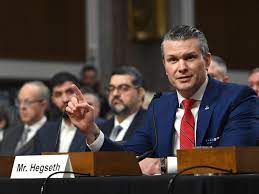
During his inaugural trip to the Indo-Pacific region, Hegseth emphasized the importance of fostering strong partnerships and collaboration among allied nations to address shared security challenges. Speaking to key military and diplomatic leaders, he underscored the strategic significance of the region in maintaining global stability and countering emerging threats.
Hegseth’s visit included engagements with regional partners to discuss joint operations, defense strategies, and capacity-building initiatives. He highlighted the critical role of interoperability and information-sharing in enhancing the collective readiness of Indo-Pacom nations.
During a press briefing, Hegseth reaffirmed the United States’ commitment to deepening alliances and supporting efforts to ensure a free and open Indo-Pacific. He stressed the need for continuous dialogue and cooperation to adapt to evolving geopolitical dynamics.
By prioritizing partnership-driven approaches, Hegseth’s trip signals a renewed focus on strengthening ties with regional allies and reinforcing the shared vision of peace and security in the Indo-Pacific.
Founded in 1995, the DKI APCSS is a DOD institute that offers a forum for military and civilian leaders from the region to come together and discuss local and global security matters.
Noting this was the first time he was able to address military and civilian leaders in the U.S. Indo-Pacific Command area of responsibility since being sworn in, Hegseth told the virtual and in-person audience that it was important for him to address that group first.
“Many of you graduated from our premier forum for studying the Indo-Pacific, and for building ties among national security leaders who are engaged in this region,” Hegseth told the audience.
“Our relationships — and our teamwork — form the foundation of achieving peace through strength,” he added.
To that end, Hegseth said achieving peace through strength will be attained by adhering to the three core tenets he listed in his Jan. 25, 2025, message to the force: restoring the warrior ethos, rebuilding the military and reestablishing deterrence.
“By restoring the warrior ethos, U.S. forces assigned to the Indo-Pacific will be the best trained and best equipped forces in the world,” Hegseth said, adding recruiting numbers are up throughout the armed services, and “our opponents are taking notice.”
Regarding rebuilding the military, Hegseth said DOD will work with the defense industrial base to “rapidly and responsively deliver the right tools to our warfighters in real time.”
He also noted that DKI APCSS has been focused on supply chain security for U.S. weapons systems, as well as studying the potential for coproduction and sustainment of U.S. military platforms and munitions with international partners.
“Please keep up the great work; we need it, [and] it is more important than ever,” Hegseth said.
Regarding reestablishing deterrence in the region, Hegseth said the U.S. will stand with its allies and partners to deter China’s aggression, and that he believes each ally, partner and friend in the region contributes their own unique manner of deterrence.
Hegseth finished his remarks by encouraging allies in the region to recommit to the partnership and to doing their part to reestablishing deterrence and, ultimately, peace through strength.

“No one should question the resolve of the United States of America to defend our interests in the Indo-Pacific and beyond,” Hegseth said.
“We will do this through the deterrent power of the strongest, most effective, most lethal fighting force in the world … supported by — and in partnership with — capable, like-minded allies and partners,” he added.
As part of his first official visit to the Indo-Pacom AOR, Hegseth is spending his time in Hawaii primarily meeting with civilian and military leaders.
Following his stay in Hawaii, Hegseth is scheduled to travel to Guam, the Philippines and Japan to meet with senior U.S. military and civilian leadership.
He also intends to participate in a series of international bilateral meetings, with a goal aimed at strengthening U.S. alliances and partnerships toward a shared vision for a free and open Indo-Pacific.





